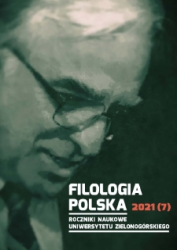Truth vibrations – in search of integrity in the literary works and minds
English
Keywords
Abstract
What accounts for the value and ethics of a literary work? That words carry energy leads to exerting a powerful impact on those exposed to them. The vibrations of words reflect the soul, which is conditioned by the state of consciousness. Energy, as harmony – is aligned with Truth, Power and the way of Heart, but if in dissonance – it is associated with lack of integrity, disruption and Force. The shape of a text stems from the wave frequency of its creator. And so do the principles of ethics, or moralistic dictum, found in or between the lines, whose nature and spectrum arise from the context that gave roots to the particular awareness rising. Unprecedented in many scientific circles and literary milieus, Consciousness levels can be defined by the calibration technique, owing to the kinesiologic responses of the body muscles. How the procedure of identifying Energy levels occurs, what calibrations the creativity of outstanding poets, novelists and dramatists (including the Nobel Prize laureates) reveals, and what influence it might have on the domain of literature, and a circle of its recipients and experts, are central to this paper.
References
Bell J.S., Speakable and Unspeakable in quantum mechanics, Cambridge (Cambridge University Press) 1987.
[Google Scholar]
Bohm D., Wholeness and the Implicate Order, London (Routledge & Kegan Paul) 1980.
[Google Scholar]
Bohr N., Atomic Structure, Nature 1921, 107 (2682) [Bibcode: 1921Natur.107.104B. doi:10.1038/107104a0].
[Google Scholar]
Born M., The Born Einstein Letters, New York (Walker and Company) 1973.
[Google Scholar]
Carter C., Science and Psychic Phenomena – The Fall of the House of Skeptics, Rochester (Inner Traditions) 2007.
[Google Scholar]
De Broglie L., The Reinterpretation of Wave Mechanics, Foundations of Physics 1970, 1 (1) [doi: [BF00708650].
[Google Scholar]
Diamond, J., Behavioral Kinesiology, New York (Harper & Row) 1979.
[Google Scholar]
Eccles J., Mind and Brain: The Many Faceted Problems, New York (Paragon House) 1986.
[Google Scholar]
Goodheart G., Applied Kinesiology, Detroit (Privately published) 1976.
[Google Scholar]
Hawkins D.R., Power vs Force, New York City, Carlsbad (Hay House, Inc.) 1995.
[Google Scholar]
Hawkins D.R., The Eye of the I, Veritas Publishing, Sedona 2001.
[Google Scholar]
Hawkins D.R., Transcending the Levels of Consciousness, New York City, Carlsbad (Hay House, Inc.) 2006.
[Google Scholar]
Hawkins D.R., Truth vs Falsehood, Toronto (Axial Publishing Company. “The energetic calibrations of literary output reflect the audience for which they are intended and are indicative of the level of interest of a writer’s readership”) 2005.
[Google Scholar]
Heisenberg W., The Physical Principles of the Quantum Theory, The University of Chicago Press 1930.
[Google Scholar]
Jung C.G., Psychological Reflections, Princeton (Princeton University Press) 1978.
[Google Scholar]
Lindley D., Uncertainty: Einstein, Heisenberg, Bohr, and the Struggle for the Soul of Science, Knopf Doubleday Publishing Group 2007.
[Google Scholar]
Lorenz E.N., Deterministic Nonperiodic Flow, “Journal of Atmospheric Science” 1963, n. 20.
[Google Scholar]
Łukowski J., Zawadzki H., A Concise History of Poland, Cambridge (Cambridge University Press) 2001.
[Google Scholar]
Nhat Hanh T., The Heart of the Buddha’s Teaching, New York (Harmony) 2015.
[Google Scholar]
Robinson A., The Last Man Who Knew Everything, New York (Plume/Penguin Group) 2006.
[Google Scholar]
Sheldrake R., Morphic Resonance, Rochester, Toronto (Park Street Press) 2009.
[Google Scholar]
Trembowski A., A 3D Perspective on Technology in Education – Drives, Dilemmas, Direction, Innovation, Inspiration, and Hope in a VUCA World 2017, vol. 13, no. 1, 21st Century Academic Forum Harvard Conference Proceedings, Bozeman, Montana [cis_harvard_2017_cp.pdf].
[Google Scholar]
Trembowski A., The Power of Consciousness & Illuminated Citizens of 2030 – Integrity, Success, Self-Actualization, Preparing Students for an Uncertain Future 2018, vol. 16, no. 1, 21st Century Academic Forum Harvard Conference Proceedings, Bozeman, Montana [21cef_harvard18-cp.pdf].
[Google Scholar]
Zafon C.R., The Shadow of the Wind, New York (The Penguin Press) 2004.
[Google Scholar]
Preview
Downloads
Published
How to Cite
Issue
Section
Categories
Copyright & License

This work is licensed under a Creative Commons Attribution-NonCommercial-NoDerivatives 4.0 International License.
Copyrights (a). In principle, authors who are not employed by the University of Zielona Góra retain the copyright, including publishing rights to the articles, without restrictions.
Copyrights (b). In principle, authors who are employed by the University of Zielona Góra, do not retain the copyright, including publishing rights to the articles. In such cases the copyright holder is the University of Zielona Góra.
Print ISSN
2450-3584-
Abstract221










































